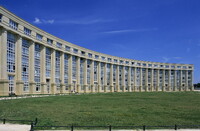| dc.coverage.spatial | Site: Montpellier, Languedoc-Roussillon, France | en_US |
| dc.coverage.temporal | 1979-1997 (creation) | en_US |
| dc.creator | Bofill, Ricardo | en_US |
| dc.date | 1979-1997 | en_US |
| dc.date.accessioned | 2013-07-25T16:11:44Z | |
| dc.date.available | 2013-07-25T16:11:44Z | |
| dc.date.issued | 1979-1997 | en_US |
| dc.identifier | 226249 | en_US |
| dc.identifier.other | archrefid: 2206 | en_US |
| dc.identifier.uri | http://hdl.handle.net/1721.3/134043 | |
| dc.description | View of the southeast wing, Ampitheater; [The district is built on the grounds of the former Joffre Barracks, of which now only the Montpellier citadel remains. Part of the development created a new visual axis 1 kilometre in length, nicknamed the Champs-Élysées of Montpellier.]
Antígone (1979-1983), Montpellier, is a recent, axial city centre enclosing monumental volumes of Baroque scale and variety. The design of these multi-storey residential complexes, whose enclosed plazas are the antithesis of the fluid, abstract spaces of modernist urban planning, was based on classical rules, but interpreted with an absolute freedom that constantly transgressed the language, proportion and scale of canonical classicism, producing elements that are often distorted and enlarged to create a disturbing colossalism. The blocks were increasingly built with the use of industrialized construction techniques such as prefabricated concrete and curtain walling systems. Bofill’s re-creation of classical urban space with its emphasis on monumentality made him one of the most important exponents of Post-modernism; the architecture of his residential complexes has more to do with meaning than with other architectural values. His work has been labelled ‘modern classicism’. Source: Grove Art Online; http://www.oxfordartonline.com/ (accessed 5/9/2011) | en_US |
| dc.format.medium | precast concrete; glass; steel | en_US |
| dc.rights | © Scott Gilchrist, Archivision, Inc. | en_US |
| dc.subject | architecture | en_US |
| dc.subject | contemporary (1960 to present) | en_US |
| dc.subject | City planning | en_US |
| dc.subject | Housing | en_US |
| dc.subject | ideal cities | en_US |
| dc.subject | Postmodern | en_US |
| dc.subject | Twentieth century | en_US |
| dc.title | Antigone District | en_US |
| dc.title.alternative | Antígone | en_US |
| dc.type | image | en_US |
| dc.rights.access | Licensed for educational and research use by the MIT community only | en_US |
| dc.identifier.vendorcode | 1A1-BR-MA-A4 | en_US |
| vra.culturalContext | French | en_US |
| vra.technique | construction (assembling) prefabrication | en_US |
| vra.worktype | housing project | en_US |
| vra.worktype | mixed-use development | en_US |
| vra.worktype | plaza | en_US |
| dc.contributor.display | Ricardo Bofill (Spanish , born 1939) | en_US |


